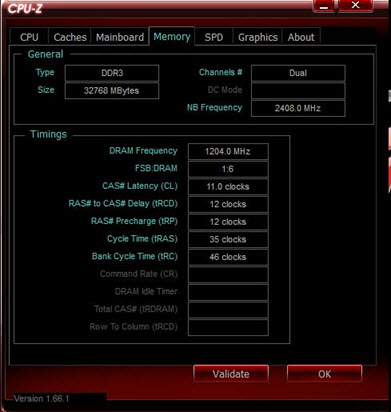DDR DRAM FAQs And Troubleshooting Guide
Why Does CPU-Z Indicate DRAM Is Only Running At X Speed?
The answer to this question depends on what you are looking at in CPU-Z. Two of the program's tabs are DRAM-related: the SPD tab and the Memory tab. We will get to the SPD tab in Item No. 10 below, but this question most often arises in the Memory tab of the program.
CPU-Z shows DRAM clock rate and timings, among other things, in the Memory tab. DRAM data rate is most often thought of as the DRAM’s "speed." Since this is DDR (double data rate) DRAM, the indicated frequency times two equals the data rate. If, for example, your DRAM is 1866 or better and you are seeing 667 (=1333) or 800 (=1600) or anything less than what equates to the spec of your DRAM (1866 should show ~933), then one of the following issues is occurring: your DRAM is not set up correctly, the motherboard or CPU isn't capable of running the specification data rate of the DRAM, or there is another problem.
An example is provided below:
The examples above show the DRAM after the initial installation. You can see that the Memory tab image is showing a true frequency of 668.9. Going back to our formula of frequency x 2 = effective data rate, 668.9 x 2 = 1337.8 (or basically 1333, the motherboard’s default).
In the SPD image, we see the XMP profile for 2400 MT/s DRAM. Asus uses DOCP in AMD rigs. These were described in item No. 5. DOCP-capable firmware doesn’t always read or report exact XMP timings. Here, they appear as DDR3-2400 with timings of 10-13-13-32 when its original XMP values are 10-12-12-31.
Once DOCP has been enabled, it sets the timings to 11-13-13-35 for 2400. After the timings were manually corrected, it showed the correct data rate of 2400 MT/s with the correctly entered timings.
Get Tom's Hardware's best news and in-depth reviews, straight to your inbox.
Current page: Why Does CPU-Z Indicate DRAM Is Only Running At X Speed?
Prev Page Will Quad-Channel DRAM Work In Dual-Channel Motherboards? Next Page Why Does CPU-Z Indicate DRAM’s Max Bandwidth Is Only X?-
das_stig With AMD motherboards, you should set the memory to unganged mode for a tiny performance improvement unless you're running a webserver.Reply -
Mahruay Nice read although could you explain what real world improvements can be seen in faster RAM.Reply -
boju Nice article, answers a lot for people and definitely will link for future references. I need to ask though, is there any reason to discriminate DDR3 as per title?Reply -
clonazepam I hope the next part covers performance when using say 3 sticks, where 2 are dual channel, 1 is single channel. Some real world results would be stellar (maybe as a follow-up?)Reply
I'd also like to see RAM drives covered. Suppose you allocate 4GB out of 16 for a RAM drive. How does the software create the 4GB? Is it using a single chunk of memory, is it taking 1GB from each of the 4 sticks? Is it from the beginning, middle or end of the 16GB of memory?
Covering how to identify true "memory leaks" versus a more common scenario where RAM usage grows intentionally from the caching of more and more assets. -
damric Great article, Tradesman! I give it Two thumbs up and two big toes up too!Reply
Only 1 issue:
Ganged vs Unganged: that actually doesn't have to do with single or dual channel.
Quote AMD:
Ganged mode means that there is a single 128bit wide dual-channel DRAM Controller (DCT)
enabled. Unganged mode enables two 64bit wide DRAM Controllers (DCT0 and DCT1).
The recommended setting in most cases is the Unganged memory mode. Ganged mode may allow slightly
higher Memory performance tuning and performs well in single-threaded benchmarks.
Depending on the motherboard and BIOS, it may be required manually setting the timing parameters for each
DCT (in Unganged mode) when performance tuning the memory or fine tuning the timings. Some BIOS
versions apply the same timings automatically for both DCTs in an Unganged mode.
Unganged is like a normal divided highway with two directions. Ganged let's traffic use all of the lanes in one direction at a time. Unganged is said to be more efficient but no one really ever tested this thoroughly to see if any applications would be better served in ganged instead. You could still have unganged single channel or dual channel, and ganged single channel or dual channel. If that's confusing I'll try to explain with more complicated interstate highway anecdote.
Lastly, I see you have a new AMD rig. Did your head explode when you saw how much more difficult it is to tune memory on that platform than on your past intel rigs?
-
Shankovich Awesome article! These kinds of articles is what brought me to Tom's in the first place years ago!Reply

